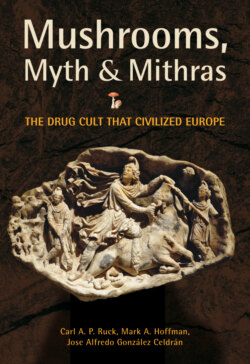Читать книгу Mushrooms, Myth and Mithras - Carl Ruck - Страница 17
На сайте Литреса книга снята с продажи.
Red Cap
ОглавлениеMithras emerged with a naked white torso but already wearing his characteristic red Phrygian cap, white stipe with red cap, sometimes speckled with stars, and often amidst fire, as in the Mithraeum of Dura-Europos, where both the cap and the rock are flaming.53 The hair is sometimes painted golden yellow, which is equally significant, not only for the god’s assimilation with Apollo-Helios but from its ethnopharmacological metaphor as Golden Fleece.54 The cap is such an essential item of his iconography, however, that he is almost never depicted without it, for which reason he has the epithet of Pileatus, the “capped one,”55 and since it is invariably red and often spotted or jeweled, he was appropriately termed the “red-capped one.”56
The metaphor of the cap is so naturally suggestive that the botanical term for the mushroom’s top is pileus, and it commonly figures in folklore and fairy tales, such as “Little Red Riding Hood,” called “Little Red-Cap” in German, and among the diminutive fairy folk frequenting forests.57 Altaic shamans who use Amanita muscaria consider their caps an essential aspect of their craft, since it is there they believe that their powers are concentrated.58
The psychoactive Psilocybe semilanceata (“half-spear” or pointed) mushroom is commonly called “liberty cap” because of its resemblance to the Phrygian cap and its association with the French revolutionaries. Its botanical description as “half-spear” probably derives from the same tradition since the Mithraic cap, atop the Sword of the Accord (a spear in this case), with its definite fungal connotations, was used in the illuminations of the Déclaration des droits de l’homme.59 It is common for easily available varieties with similarly psychoactive properties to be substituted for the original sacrament; thus the Psilocybe resembles the bonnet rouge, but obviously lacks its distinctive red color.
